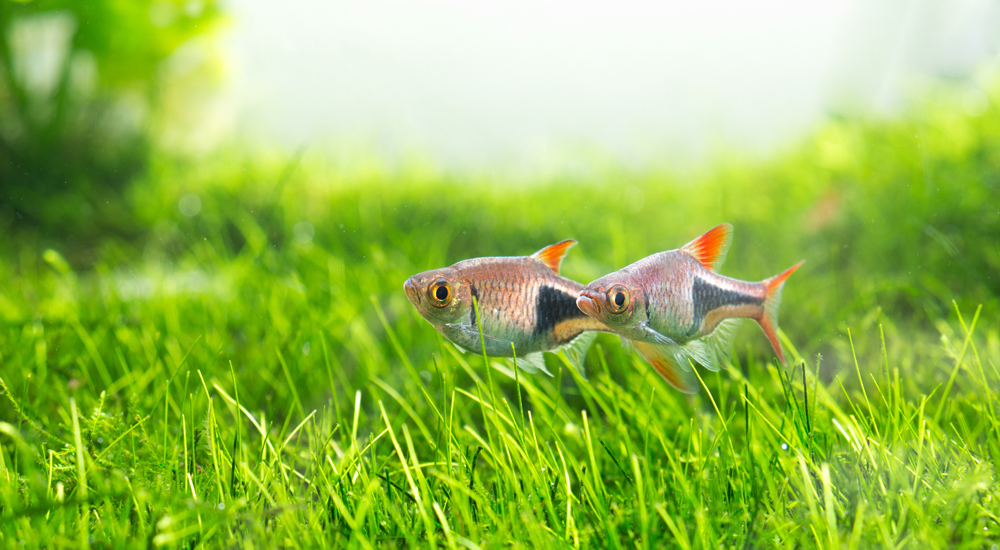When we closely observe the behaviour of our aquarium fishes we soon get used to their swimming patterns and posture, recognising different ‘personalities’ in fish, such as boldness or aggression towards tank mates. Any departure from this usual state of affairs is often the first sign that there is a problem, and a fish that starts twitching, shimmying, shaking, rubbing, flicking or flashing against objects in the tank can often be a sign of a potentially serious issue.
Fish flick and scratch for the same reasons that other animals including humans, they are trying to relieve irritation and dislodge foreign objects from the skin. Different fishes will show many varieties of this behaviour. Open water shoaling fishes may frequently visit the substrate of the tank and very rapidly rub their flanks against the gravel or sand – blink and you will miss it. More sedentary bottom dwellers can be observed ‘rocking’ against items of hardscape in the tank.
Erratic behaviour in fishes may not always indicate a problem with their fish. Interestingly many Corydoras catfishes can often be observed darting up to the water surface incredibly quickly before resuming their bottom-dwelling location. This isn’t another form of the flicking/flashing behaviour, in fact, Corydoras under these circumstances are taking little gulps of air down into their intestine where a highly vascularised portion of the gut is able to extract the oxygen from the air. Should your Corydoras be showing this behaviour then consider increasing the aeration in the tank, but there should be no need to worry that the fish’s skin is being damaged or irritated.
The skin of a fish provides numerous important functions; it is a barrier against the external environment, sealing the internal mileu of the fish and preventing infection by pathogens. Most notably the skin contains the scales, which form a tough outer armour present on most aquarium and pond fishes. The skin is the site of protective mucous secretion amongst other immune factors, it houses receptors for touch, smell and even taste.
We can separate the skin of fishes into two principal layers, an inner dermis which contains blood vessels, nerves and sensory receptors, scales and connective tissues. Beneath this layer lies the muscle and above lies the epidermis, (‘epi’ meaning ‘on top of’). The epidermal layer contains many layers of cells that are toughened with the protein keratin in many species. Also present are mucous producing goblet cells in the epidermis.
There are two principle irritants to the skin, water-borne pollutants and pathogenic infections. Flicking, flashing and scratching behaviours could be caused by irritation of the skin by high ammonia levels in the water, extremes of pH or residual chlorine in the water due to ineffective or absent tapwater conditioning. Clearly thorough testing of the water is going to be essential, for many fishkeepers water testing is only undertaken when problems such as this arise. Tetra’s new water testing app, used in conjunction with Tetra’s 6in1 test strips will allow rapid and accurate determination of the water quality using your smartphone, and provide recommendations on how to treat the water, such as adding Tetra EasyBalance to reduce the number of water changes and stabilise important water values.
Any ammonia in the water is likely to be detrimental to the fish and causing skin irritation amongst many other deleterious symptoms. Admittedly, the toxicity of ammonia is pH dependent, however, it is best to regard ammonia as toxic, full stop! Obviously different fishes are adapted to varying pH ranges and this must be taken into account before considering if the pH value is extreme for the fish. In addition, the historical pH values will be important, if there is a rapid, sudden and large change in the pH this can cause considerable skin irritation to the fish whereas a slow onset change within the same values may be adapted to.
When any fish are flicking and scratching in an aquarium the first action to take is a thorough appraisal of the water quality, this can hopefully be viewed in the context of historical readings. If water quality is the source of the problem then this will obviously need to be corrected. Ammonia levels can be high in new aquaria that have not been properly matured, in overstocked or overfed tanks and can commonly occur in tanks following a significant power cut. If the pH value is found to be substantially lower than the fish would prefer, then it is important to check the carbonate hardness (KH), also. Carbonate hardness is able to buffer the water against pH change, hence by monitoring and maintaining KH we can prevent sudden and severe plummets in the acidity of the tankwater. If the pH is found to be extremely high, then the most likely explanation is that some new calciferous rockwork has been added to the tank, this will have leached alkaline minerals into the water forcing the pH substantially upwards.
It might be the case that this water quality analysis fails to turn up any obvious suspect parameter, perhaps a more sinister water parameter is to blame such as copper, or more likely the fish are infected with ectoparasites. There are numerous organisms that can thrive on the skin of stressed fishes, some graze the mucous or epidermal cells, others burrow deeper to the dermal layer whilst large ectoparasites like the fish leech or the fish louse are seeking the fish’s nutritious blood supply.
Effective diagnosis is the key, addition of an antiparasitic agent to treat flicking / flashing fish, when the real cause was ammonia poisoning or an extreme of pH, would be catastrophic, hence water quality problems must be ruled out first. Ironically many ectoparasites only infect fishes already pre-stressed by some other factor – most likely poor water quality!
If water quality can be truly ruled out, the type of parasite causing the problem must be determined so the best treatment can be selected. Some ectoparasites are large enough to see with the naked eye, other require a procedure involving scraping some skin mucus from the fish and examining this under a microscope. Some ectoparasites such can be treated with a mild long-term salt bath, (assuming the fish will tolerate the salt), other require specific aquarium fish antiparasitic treatments such as Tetra ContraSpot. Large ectoparasites such as the fish lice require very targeted treatment. Getting the diagnosis correct is crucial.
Fish flick and scratch to relieve skin irritation, finding the cause of the irritation, be it due to water quality, ectoparasites or perhaps both, and taking the correct course of action is vital.

